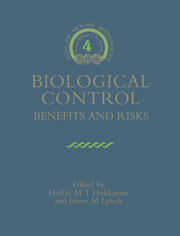Book contents
- Frontmatter
- Contents
- List of Contributors
- Series Preface
- Preface: Overview of Benefits and Risks of Biological Control Introductions
- Part I Biological Invasions
- Part II Classical Biocontrol
- Part III Augmentative Biocontrol
- Part IV Use of Genetically Modified Organisms
- 19 Assessing the Potential Benefits and Risks of Introducing Natural and Genetically Manipulated Bacteria for the Control of Soil-borne Root Diseases
- 20 Serodiagnostic Methods for Risk Assessment of Pseudomonas cepacia as a Biocontrol Agent
- 21 Benefits and Risks of Using Genetically Engineered Baculoviruses as Insecticides
- 22 Mathematical Modelling of Gene Exchange in Soil
- 23 Pest Resistance to Bacillus thuringiensis: Ecological Crop Assessment for Bt Gene Incorporation and Strategies of Management
- 24 An International Perspective for the Release of Genetically Engineered Organisms for Biological Control
- Part V Economics and Registration
- Index
24 - An International Perspective for the Release of Genetically Engineered Organisms for Biological Control
Published online by Cambridge University Press: 07 May 2010
- Frontmatter
- Contents
- List of Contributors
- Series Preface
- Preface: Overview of Benefits and Risks of Biological Control Introductions
- Part I Biological Invasions
- Part II Classical Biocontrol
- Part III Augmentative Biocontrol
- Part IV Use of Genetically Modified Organisms
- 19 Assessing the Potential Benefits and Risks of Introducing Natural and Genetically Manipulated Bacteria for the Control of Soil-borne Root Diseases
- 20 Serodiagnostic Methods for Risk Assessment of Pseudomonas cepacia as a Biocontrol Agent
- 21 Benefits and Risks of Using Genetically Engineered Baculoviruses as Insecticides
- 22 Mathematical Modelling of Gene Exchange in Soil
- 23 Pest Resistance to Bacillus thuringiensis: Ecological Crop Assessment for Bt Gene Incorporation and Strategies of Management
- 24 An International Perspective for the Release of Genetically Engineered Organisms for Biological Control
- Part V Economics and Registration
- Index
Summary
Introduction
During the 1970s a set of powerful biochemical tools became available for the characterization and manipulation of nucleic acids and proteins. These included the ability to sequence DNA segments rapidly, to excise specific segments, to execute changes to the nucleotide sequences, if and as desired, and then to insert the modified segment elsewhere into the genome. During this period it was also demonstrated that genetic material could be transferred into the genomes of foreign organisms and, under appropriate conditions, be expressed thus leading to synthesis of RNA and protein products. For example ‘expression systems’ using eukaryote genes coding for proteins such as interferon, insulin, growth regulators, etc. could be constructed in bacteria, yeast, insect or other eukaryote tissue cultures. Expression of these foreign genes in the host represented a valuable source of such products.
In the latter part of the 1970s and for much of the 1980s, recombinant-DNA technology was largely used as a powerful and creative tool in molecular biology and genetic analysis. It was principally directed towards fundamental questions such as the improvement of our understanding of gene structure and function and for unravelling chromosome organization.
The notion that novel genetic combinations could be created with recombinant-DNA (r-DNA) technology, which would have been unlikely or impossible to arise in nature, caused molecular biologists to pause and consider the risks from inadvertent or deliberate construction of novel organisms that might cause environmental or health problems should they enter the environment by accident or design.
- Type
- Chapter
- Information
- Biological ControlBenefits and Risks, pp. 253 - 260Publisher: Cambridge University PressPrint publication year: 1995
- 2
- Cited by



